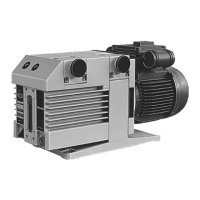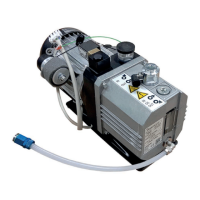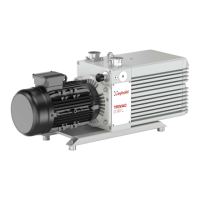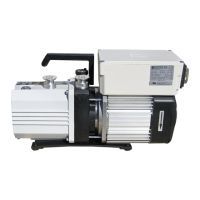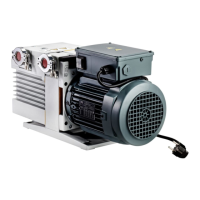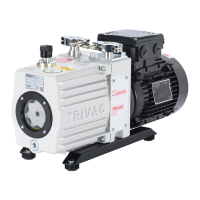t
I
NOTE: On extreme-corrosive service pumps, the gas ballast valve (17) is sealed to prevent gases in the air
wit,h
secondary, gases or vapors in pump, These pumps have a port on
the
valve (17) for
Installing a dry nitrogen gas line (see Sketch 2-1); the port is
Va
inch NPT for the D2A and D4A models and
V4
inch NPT for
alT
other TRIVAC A models, The maximum nitrogen pressure is 2 psig delivered to the pump,
ADAPTER WITH
NPT PORT
EPOXY SEAL
This isn't a standard
modification; it
is
SEALED WITH EPOXY
GAS
BALLAST
VALVE
(17)
. made primarily to
extreme-corrosive
service pumps.
RETAINING WASHER (21)
2-4
lTA-1.2
Sketch
2-1
Cross Section of the Gas Ballast Valve on the DaAlAC Extreme-Corrosive Service Pumps.
PUMP FLUID
The
pump
fluid
partially fills the oil
casing
(12).
It
is
injected from the oil casing (12)
into
the module through
one
or
two
oil nozzles (56) located in the second
stage
pump cylinder (46)
(see
Figure 5-8). Pump
fluid
consump·
tion
is
minimal during normal operation,
but
increases
when operating at high
pressures
or
with
the
gas
ballast
valve
open.
In
addition
to
lubricating the moving parts, the pump
fluid
seals
the clearances in the pumping module. This
fluid
seal
is
necessary
for
achieving the ultimate
pressure
of
the pump. The pump
fluid
also
transfers heat from
the pumping element
to
the oil
casing
(12).
Other important qualities
of
the pump
fluid
include the following:
-It
must
have
a
low
vapor pressure at the high temperature generated by
gas
compression
and
vane
friction.
-It
must
be
oxidation resistant.
-It
must
have
a
low
water absorption rate.
-It
must resist cracking under the mechanical
stress
of
gas
compression and
vane
pressure.
Based
on operational testing,
we
have
approved the following vacuum pump fluids
for
use
in
TRIVAC
"A"
pumps:
Standard Applications HE-175 (hydrocarbon)
Corrosive Applications HE-200
or
HE-400 (hydrocarbon)
Extreme-Corrosive Applications H
E-1600 (perfluoropolyether)
High·Temperature Applications
HE-600 (synthetic diester hydrocarbon)
If
you
use
a nonapproved pump
fluid,
we
can't guarantee that our pumps
will
meet their operating specifications
(ultimate pressure, pumping speed, operating temperature, etc.). However,
the
warranty
is voided only if the non-
approved fluid adversely
affects
the operation or reliability
of
the
pump. The
pump's
identification plate (see
Page
3)
indicates which pump fluid was initially used in the pump.
Section 2-3-2 mentions the detrimental effects
of
condensate on the pump
fluid.
Contaminants
also
destroy many
of
the essential qualities
of
the
fluid,
resulting in pump wear, slower pumping speed, higher ultimate pressure, and
sometimes pump seizure.
Change
the pump
fluid
frequently
to
ensure good performance and
to
extend the life
of
your pump.
TRIVAC
''A"
Manual, Edition L
7
i
I
)
,
I'
